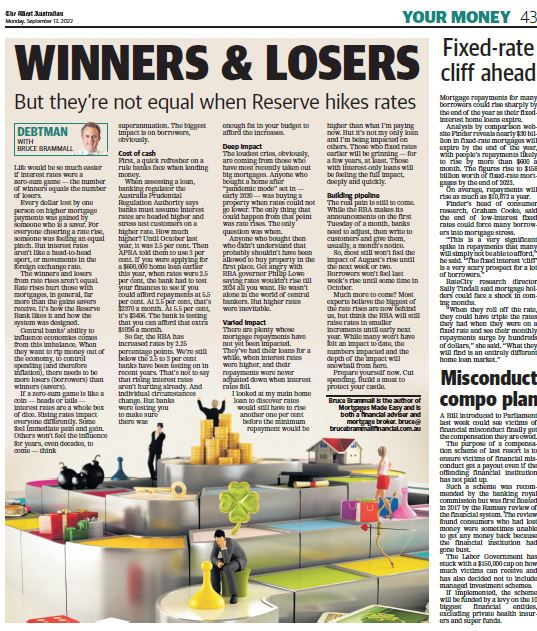
Bruce Brammall, The West Australian, 12 September, 2022
Life would be so much easier if interest rates were a zero-sum game. Number of winners equals number of losers.
Every dollar lost by one person on higher mortgage payments was gained by someone who is a saver. For everyone cheering a rate rise, someone was feeling an equal pinch.
But interest rates aren’t like a head-to-head sport, or movements in the foreign-exchange rate.
The winners and losers from rate rises aren’t equal. Rate rises hurt those with mortgages, in general, far more than the gains savers receive.
It’s how the Reserve Bank likes it and how the system was designed.
Central banks ability to influence economies comes from this imbalance. When they want to rip money out of the economy, to control spending (and therefore inflation), there needs to be more losers (borrowers) than winners (savers).
If a zero-sum game is like a coin (heads or tails), interest rates are a whole box of dice.
Rising rates impact everyone differently. Some feel immediate pain and gain. Others won’t feel the influence for years, even decades, to come (superannuation).
The biggest impact is on borrowers, obviously.
Cost of cash
First, a quick refresher on a rule banks face when lending money.
When assessing a loan, banking regulator APRA says banks must assume interest rates are headed higher and stress test customers on a higher rate.
How much higher? Until October last year, it was 2.5 per cent. Then APRA told them to use 3 per cent.
That means that if you were applying for a $600,000 home loan earlier this year, when home loan interest rates were 2.5 per cent, the bank had to test your finances to see if you could afford repayments at 5.5 per cent.
At 2.5 per cent, repayments are $2370 a month. At 5.5 per cent, it’s $3406. The bank is testing that you can afford that extra $1036 a month.
So far, the RBA has increased rates by 2.25 percentage points. We’re still below the 2.5 to 3 per cent banks have been testing on in recent years.
That’s not to say that rising interest rates aren’t hurting already. And individual circumstances change. But banks were testing you to make sure there was enough fat in your budget to afford the current increases.
Deep impact
The loudest cries, obviously, are coming from those who have most recently taken out big mortgages.
Anyone who bought a home after “pandemic mode” set in (early 2020) was buying a property when rates could not go lower.
The only thing that could happen from that point was rate rises. The only question was when.
Anyone who bought then who didn’t understand that … probably shouldn’t have been allowed to buy property in the first place.
(Get angry with RBA Governor Phillip Lowe saying rates wouldn’t rise till 2024 all you want. He wasn’t alone in the world of central bankers. But higher rates were inevitable.)
Varied impact
There are plenty whose mortgage repayments have not yet been impacted. They’ve had their loans for a while, when interest rates were higher, and whose repayments were never adjusted down when interest rates fell.
I looked at my main home loan to discover rates would still have to rise another 1 per cent before the minimum repayment would be higher than what I’m paying now. But it’s not my only loan and I’m being impacted on others.
Those who fixed rates earlier will be grinning … for a few years, at least. Those with interest-only loans will be feeling the full impact, deeply and quickly.
Building pipeline
The real pain is still to come.
While the RBA makes its announcements on the first Tuesday of a month, banks needs to adjust, then write to customers and give them, usually, a month’s notice.
So, most still haven’t felt the impact of the latest rise.
Much more to come?
Most experts believe the biggest of the rate rises are now behind us, but think the RBA will still raise rates in smaller increments until early next year.
While many won’t have felt an impact to date, the numbers impacted and the depth of the impact will snowball from here.
Prepare yourself now. Cut spending. Build a moat to protect your castle.
Bruce Brammall is the author of Mortgages Made Easy and is both a financial adviser and mortgage broker. E: bruce@brucebrammallfinancial.com.au.